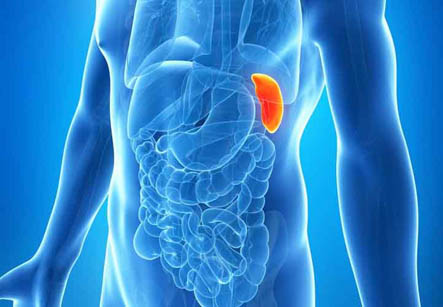Blunt Splenic Trauma
Introduction
Blunt splenic trauma refers to a significant impact on the spleen from some outside source (like an automobile accident) damages or ruptures the spleen. Treatment can vary depending on severity of the trauma as well as condition of the patient. But the standard treatment often consists of embolism or splenectomy (removal of spleen).
Cause
Although, the spleen is well protected in the rib cage, the most important cause of blunt splenic trauma is an automobile accident. It is also a leading cause of internal bleeding. However, any type of major impact on the spleen may cause this type of injury. Another example is a bicycling accident in which the handlebar is forced into the left subcostal margin impacting the spleen. It can also occur in sporting injuries and domestic violence. Some people have a tendency for splenic rupture even from a trivial injury. The severity of injury can range from sub-capsular hematoma to splenic rupture.
Medical Concerns
The primary medical concern in any splenic trauma is internal hemorrhage, as spleen is very vascular organ. The hemorrhage may be small or large, which depends upon the nature and degree of injury. Small or minor injuries may heal spontaneously, particularly in children. Larger injuries can be fatal as there is extensive hemorrhage. It may lead to hemorrhagic shock. Also, there may be delayed rupture of a splenic hematoma which can happen from hours to even months after the injury.
Blunt splenic trauma occurs when a significant impact to the spleen from some outside source (i.e. automobile accident) damages or ruptures the spleen

Signs and Symptoms
The primary result of splenic trauma is hemorrhage. It can present according to the extent and severity of injury.
1. Major hemorrhage- it presents as hemorrhagic shock (a name for collapse of circulatory system due to blood loss), abdominal pain, and significant abdominal distention. Early features of shock are tachycardia, tachypnea, restlessness, and anxiety associated with mild pallor. Decreased pulse pressure may be noted.
2. Minor hemorrhage-it often presents as pain in upper left quadrant of abdomen.
3. In patients with unexplained left upper quadrant pain presenting with hypovolemia or shock, a splenic injury should be suspected.
4. In severe cases, evidence of peritonitis can be present such as severe diffuse pain in abdomen, abdominal rigidity and tenderness to touch. Rebound tenderness may be present.
5. Left shoulder tenderness can be a presenting symptom in splenic trauma due to irritation of sub-diaphragmatic nerve root leading to referred pain.
6. Hypotension in a young and otherwise healthy splenic trauma patient is an ominous sign and requires immediate evaluation and intervention.
Diagnosis
A CT scan is a reliable investigation for splenic trauma. For a severely injured patient, bedside ultrasound can be done. Exploratory laparotomy needs to be done only in case of severe hemorrhage and rapidly deteriorating patient. CT scan grading criteria has been created to identify the need for surgery and for deciding the intervention among surgery or embolization in patients with splenic injury. The criterion is useful for hemodynamically stable patients with blunt splenic trauma.
The following three CT findings are important for the decision of the intervention
1. Laceration involving more than 50% of the splenic parenchyma.
2. Pseudo-aneurysm formation or extravasation of IV contrast dye due to leaking from small torn vessels producing a contrast blush> 1cm.
3. Large hemoperitoneum (or blood in the peritoneum).
Treatment
Splenectomy is the standard treatment for blunt splenic trauma. But the conservative approach is tried in few stable patients.
Conservative management
Although, the spleen is well protected in the rib cage, the most important cause of blunt splenic trauma is an automobile accident.
Only hemodynamically stable patients are suitable for conservative approach. Splenectomy may also be avoided in children as the absence of spleen permanently makes the children susceptible to various bacterial infections. Most small, and some moderate-sized lacerations of spleen can be managed by this approach in stable patients. They should be managed in well-equipped intensive care unit as careful cardiovascular and hematological monitoring is required. Plasma expanders and blood may be required to replace the lost volume.
Embolization
It is a procedure in which the offending hemorrhaging vessels are blocked. This is a new and less invasive treatment than surgery. It is done when the conservative approach fails.
Splenectomy
This is still the primary surgical treatment in which the hemorrhagic and lacerated spleen is removed by opening the abdomen. The abdominal cavity is washed and cleansed thoroughly to remove blood and other necrotic tissues. Abdomen is closed after putting drains. This surgery has the highest success rate in blunt trauma of spleen.